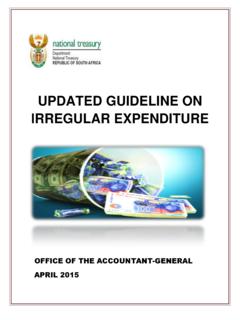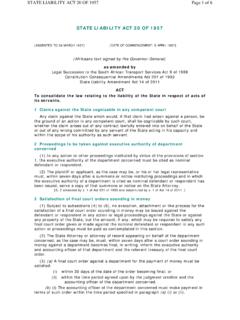Transcription of GUIDELINE ON UNAUTHORISED EXPENDITURE - Treasury
1 GUIDELINE ON UNAUTHORISED EXPENDITURE GUIDELINE ON UNAUTHORISED EXPENDITURE OFFICE OF THE ACCOUNTANT-GENERAL May 2014 GUIDELINE ON UNAUTHORISED EXPENDITURE 1 PURPOSE 1. The purpose of this GUIDELINE is to provide clarity on the interpretation of matters related to UNAUTHORISED EXPENDITURE , as defined in section 1 of the Public Finance Management Act (PFMA), 1999 (Act No. 1 of 1999) and the application of procedures related thereto. DEFINITIONS 2. The following definitions are relevant in relation to UNAUTHORISED EXPENDITURE : Definitions in terms of section 1 of the PFMA Description Irregular EXPENDITURE Irregular EXPENDITURE means EXPENDITURE , other than UNAUTHORISED EXPENDITURE , incurred in contravention of or that is not in accordance with a requirement of any applicable legislation, including: (a) the PFMA; (b) the State Tender Board Act, 1968 (Act No.)
2 86 of 1968), or any regulations made in terms of that Act; or (c) any provincial legislation providing for procurement procedures in that provincial government. Main Division within a vote (often referred to as a Programme) One of the segments into which the vote is divided and which specifies the total amount which is appropriated for the item under that segment and is approved by Parliament or a provincial legislature, as may be appropriate, as part of the vote. Overspending When EXPENDITURE under the vote exceeds the amount appropriated for that vote or in relation to a main division when EXPENDITURE under the main division exceeds the amount appropriated for that main division, subject to the virement rules contained in section 43 of the PFMA. UNAUTHORISED EXPENDITURE (a) overspending of a vote or a main division within a vote; or (b) EXPENDITURE that is made not in accordance with the purpose of a vote or, in the case of a main division, not in accordance with the purpose of the main division.
3 GUIDELINE ON UNAUTHORISED EXPENDITURE 2 Definitions in terms of section 1 of the PFMA Description Vote One of the main segments into which an Appropriation Act is divided and which specifies the total amount which is usually appropriated per department in an Appropriation Act and is separately approved by Parliament or the provincial legislature, as may be appropriate, before it approves the relevant draft Appropriation Act as such. APPLICABILITY 3. Taking cognizance of the definitions contained in paragraph 2 above, the concept of UNAUTHORISED EXPENDITURE is only applicable to departments. LEVEL AT WHICH PARLIAMENT AND THE RELEVANT PROVINCIAL LEGISLATURES APPROPRIATE MONEY FOR DEPARTMENTS TO CARRY OUT THEIR MANDATES 4. Given the definition, UNAUTHORISED EXPENDITURE is only calculated at the level of a vote or main division within a vote since it is at these levels that Parliament and the relevant provincial legislature appropriate money.
4 5. Whilst some Appropriation Acts provide budgetary information at economic classification level, such is only provided as a breakdown of the appropriation. An example of such is contained in extracts of an Appropriation Bill for national departments and the Appropriation Act, 2013 of a province, which are enclosed as Annexures A and B respectively. DISTINCTION BETWEEN UNAUTHORISED EXPENDITURE AND IRREGULAR EXPENDITURE 6. If a department incurs EXPENDITURE that contravenes any applicable legislation, such EXPENDITURE meets with the definition of irregular EXPENDITURE and must be classified as such. 7. Should the same EXPENDITURE in paragraph 6 above relate to the procurement of goods or services that is not in accordance with the purpose of the vote or main division within a vote or which results in the overspending of the main vote or main division within a vote, such EXPENDITURE also meets with the definition of UNAUTHORISED EXPENDITURE .
5 GUIDELINE ON UNAUTHORISED EXPENDITURE 3 8. Transactions such as those in paragraphs 6 and 7 above may not be accounted for as both irregular and UNAUTHORISED EXPENDITURE . Considering that irregular EXPENDITURE is defined as EXPENDITURE other than UNAUTHORISED EXPENDITURE , this means that UNAUTHORISED EXPENDITURE shall take precedence over irregular EXPENDITURE . PFMA PROVISIONS RELATED TO UNAUTHORISED EXPENDITURE 9. Section 38 of the PFMA spells out the following general responsibilities of accounting officers related to UNAUTHORISED EXPENDITURE : (i) Section 38(1)(c)(ii) and section 39(1)(b): The accounting officer must take effective and appropriate steps to prevent UNAUTHORISED EXPENDITURE ; (ii) Section 38(1)(g): The accounting officer must on discovery of UNAUTHORISED EXPENDITURE , immediately report, in writing, report particulars of the EXPENDITURE to the relevant Treasury ; (iii) Section 38(1)(h)(iii): The accounting officer must take effective and appropriate disciplinary steps against any official in the service of the department who makes or permits UNAUTHORISED EXPENDITURE .
6 And (iv) Section 40(3)(b): The annual report and audited financial statements must include particulars of any UNAUTHORISED EXPENDITURE that occurred during the financial year and any criminal or disciplinary steps taken as a result of such UNAUTHORISED EXPENDITURE . 10. Section 45(c) of the PFMA requires an official of a department to take effective and appropriate steps to prevent UNAUTHORISED EXPENDITURE within that official s area of responsibility. Treasury REGULATION PROVISIONS RELATED TO UNAUTHORISED EXPENDITURE 11. In terms of section 76(2)(e) of the PFMA, the National Treasury may make regulations or issue instructions applicable to departments on, amongst others, UNAUTHORISED EXPENDITURE . 12. In line with section 76(2)(e) above, the National Treasury issued the following regulations: GUIDELINE ON UNAUTHORISED EXPENDITURE 4 Treasury Regulations Description Treasury Regulation The accounting officer of a department must exercise all reasonable care to prevent and detect UNAUTHORISED EXPENDITURE and must, for this purpose, implement effective, efficient and transparent processes of financial and risk management.
7 Treasury Regulation When an official of a department discovers UNAUTHORISED EXPENDITURE , that official must immediately report such EXPENDITURE to the accounting officer. The UNAUTHORISED EXPENDITURE must also be reported in the department s monthly report to the relevant Treasury , as required in terms of section 40(4)(b) of the PFMA. Treasury Regulation When an accounting officer determines the appropriateness of disciplinary steps to be taken against an official in terms of section 38(1)(g) of the PFMA, the accounting officer must take into account (a) the circumstances of the transgression; (b) the extent of the EXPENDITURE involved; and (c) the nature and seriousness of the transgression. Treasury Regulation The recovery of losses or damages resulting from UNAUTHORISED EXPENDITURE must be dealt with in accordance with Treasury Regulation 12 related to the Management of Losses.
8 Treasury Regulation The amount of the UNAUTHORISED EXPENDITURE must be disclosed as a note to the department s annual financial statements. VIREMENT BETWEEN MAIN DIVISIONS WITHIN A VOTE 13. Section 43(1) of the PFMA allows an accounting officer of a department to utilize a saving in the amount appropriated under a main division within a vote towards the defrayment of excess EXPENDITURE under another main division within the same vote, unless the relevant Treasury directs otherwise. 14. Section 43(2) of the PFMA provides that the amount of the saving referred to in section 43(1), may not exceed 8% of the amount appropriated under that main division. The 8% limitation is GUIDELINE ON UNAUTHORISED EXPENDITURE 5 restricted to the main division from which the saving is to be transferred from whilst no limitation exists for the main division that receives the saving.
9 15. Section 43(4) of the PFMA, does not authorize the utilization of a saving in: (a) an amount specifically and exclusively appropriated for a purpose mentioned under a main division within a vote; (b) an amount appropriated for transfer to another institution; and (c) an amount appropriated for capital EXPENDITURE in order to defray current EXPENDITURE . 16. In addition to section 43(4) of the PFMA, Treasury Regulation states that for purposes of section 43(1): (a) compensation of employees and transfers and subsidies to other institutions, excluding transfers and subsidies to other levels of government for purposes of paying levies and taxes imposed by legislation, may not be increased without approval of the relevant Treasury ; (b) new transfers and subsidies to other institutions may not be introduced without the approval of the relevant Treasury .
10 (c) allocations earmarked by the relevant Treasury for a specific purpose (excluding compensation of employees) may not be used for other purposes, except with its approval, and (d) virement of funds from compensation of employees to transfers and subsidies for the payment of severance/exit packages are excluded from the provisions of (a) and (b). DISTINCTION BETWEEN VIREMENT AND SHIFTING OF FUNDS 17. Virement is the movement of funds from one main division within a vote to another main division with the same vote. Shifting of funds takes place between economic classifications within a main division of a vote. AMENDMENTS TO SECTION 43(4)(b) and 43(4)(c) OF THE PFMA IN SECTION 5 OF THE NATIONAL ANNUAL APPROPRIATION ACT (AS IT RELATES TO VIREMENT) 18. Section 43(4) of the PFMA, does not authorize the utilization of a saving in: GUIDELINE ON UNAUTHORISED EXPENDITURE 6 (a) an amount specifically and exclusively appropriated for a purpose mentioned under a main division within a vote; (b) an amount appropriated for transfer to another institution; and (c) an amount appropriated for capital EXPENDITURE in order to defray current EXPENDITURE .











